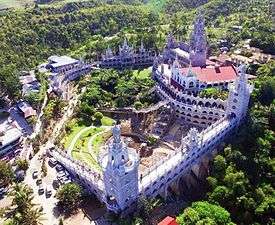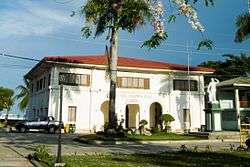Sibonga, Cebu
| Sibonga | |
|---|---|
| Municipality | |
|
Sibonga Municipal Hall | |
 Map of Cebu with Sibonga highlighted | |
.svg.png) Sibonga Location within the Philippines | |
| Coordinates: 10°02′N 123°34′E / 10.03°N 123.57°ECoordinates: 10°02′N 123°34′E / 10.03°N 123.57°E | |
| Country | Philippines |
| Region | Central Visayas (Region VII) |
| Province | Cebu |
| District | 1st district of Cebu |
| Barangay |
25 (see § Barangays)
|
| Government [1] | |
| • Type | Sangguniang Bayan |
| • Mayor | Caroline Bacaltos (NP) |
| • Vice Mayor | Cirilo Apuda |
| • Town Council |
Members
|
| • Representative | Gerald Gullas |
| Area[2] | |
| • Total | 133.45 km2 (51.53 sq mi) |
| Population (2015 census)[3] | |
| • Total | 48,186 |
| • Density | 360/km2 (940/sq mi) |
| • Voter (2016)[4] | 27,317 |
| Time zone | PST (UTC+8) |
| ZIP code | 6020 |
| IDD : area code | +63 (0)32 |
| Income class | 3rd class |
| PSGC | 072246000 |
Sibonga is a 3rd municipal income class municipality in the province of Cebu, Philippines.[2] According to the 2015 census, it has a population of 48,186.[3] In the 2016 electoral roll, it had 27,317 registered voters.[4]
Sibonga has begun developing the town to become more industrial while still preserving its natural bounty. Sibonga is abundant in root crops, corn, rice, coconuts among others. The public market is held every Saturday in Poblacion.
Sibonga also now has Sibonga Community College which offers 4-year courses to its inhabitants.
The town fiesta is on 10 August. This celebrates the feast of Saint Philomena. Sibonga has 2 patron saints; Saint Philomena and Our Lady of the Pillar.
Barangays
Sibonga comprises 25 barangays:
| PSGC | Barangay | Population | ±% p.a. | |||
|---|---|---|---|---|---|---|
| 2015[3] | 2010[5] | |||||
| 072246001 | Abugon | 4.5% | 2,162 | 1,903 | 2.46% | |
| 072246002 | Bae | 2.4% | 1,153 | 983 | 3.08% | |
| 072246003 | Bagacay | 5.0% | 2,430 | 2,074 | 3.06% | |
| 072246004 | Bahay | 10.4% | 5,013 | 4,476 | 2.18% | |
| 072246005 | Banlot | 3.9% | 1,871 | 1,612 | 2.88% | |
| 072246006 | Basak | 2.3% | 1,106 | 927 | 3.42% | |
| 072246007 | Bato | 3.1% | 1,477 | 1,297 | 2.51% | |
| 072246008 | Cagay | 1.7% | 816 | 813 | 0.07% | |
| 072246009 | Can‑aga | 2.1% | 1,011 | 776 | 5.17% | |
| 072246010 | Candaguit | 4.9% | 2,360 | 2,216 | 1.21% | |
| 072246011 | Cantolaroy | 1.3% | 634 | 567 | 2.15% | |
| 072246012 | Dugoan | 1.6% | 783 | 590 | 5.54% | |
| 072246013 | Guimbangco‑an | 2.2% | 1,067 | 788 | 5.94% | |
| 072246014 | Lamacan | 4.1% | 1,971 | 1,563 | 4.52% | |
| 072246015 | Libo | 2.4% | 1,161 | 987 | 3.14% | |
| 072246016 | Lindogon | 3.4% | 1,648 | 1,563 | 1.01% | |
| 072246017 | Magcagong | 2.1% | 991 | 906 | 1.72% | |
| 072246018 | Manatad | 3.0% | 1,428 | 1,543 | −1.46% | |
| 072246019 | Mangyan | 4.7% | 2,248 | 1,952 | 2.72% | |
| 072246020 | Papan | 1.7% | 816 | 673 | 3.74% | |
| 072246021 | Poblacion | 13.5% | 6,522 | 5,597 | 2.96% | |
| 072246022 | Sabang | 5.0% | 2,407 | 2,397 | 0.08% | |
| 072246023 | Sayao | 3.7% | 1,772 | 1,507 | 3.13% | |
| 072246024 | Simala | 6.3% | 3,025 | 3,991 | −5.14% | |
| 072246025 | Tubod | 4.8% | 2,314 | 2,177 | 1.17% | |
| Total | 48,186 | 43,641 | 1.90% | |||
Demographics
| Population census of Sibonga | ||
|---|---|---|
| Year | Pop. | ±% p.a. |
| 1903 | 25,848 | — |
| 1918 | 27,199 | +0.34% |
| 1939 | 21,803 | −1.05% |
| 1948 | 19,230 | −1.39% |
| 1960 | 19,516 | +0.12% |
| 1970 | 22,212 | +1.30% |
| 1975 | 24,510 | +1.99% |
| 1980 | 27,513 | +2.34% |
| 1990 | 33,083 | +1.86% |
| 1995 | 35,897 | +1.54% |
| 2000 | 38,281 | +1.39% |
| 2007 | 40,765 | +0.87% |
| 2010 | 43,641 | +2.51% |
| 2015 | 48,186 | +1.90% |
| Source: Philippine Statistics Authority[3][5][6][7] | ||
In the 2016 electoral roll, it had 27,317 registered voters, meaning that 57% of the population are aged 18 and over.[4]
Pastores de Sibonga

Pastores de Sibonga is a short Christmas play which narrates the nativity as performed in Magcagong. The play depicts the shepherds' adoration of the child Jesus. Pastores de Sibonga dates back to the 1920s.[8][9][10]
Pastores de Sibonga is performed by at least four dancers. The female dancer wears a red blouse or shirt paired with a long white skirt. The male dancer wears a red shirt paired with black pants. Accessories include a round hat decorated with cut-outs of the sun, moon and stars in yellow, red, green, and other brightly colored papers together with a yellow sash placed across the body. It is performed used red fans and white handkerchiefs. An oval-shaped native fan is used and held by the right hand during the performance. The white square handkerchief is held by the left hand folded into a triangular shape.
The accompaniment music is a rondalla – a ensemble (guitar, bandurria, and banjo), played with the plectrum. The lyrics tell of the pre-, nativity, and post-nativity settings. It expresses happiness, joy, and worship, and offers praises and gifts for Jesus, Mary and Joseph.
References
- ↑ "Municipality". Quezon City, Philippines: Department of the Interior and Local Government. Retrieved 31 May 2013.
- 1 2 "Municipal: Sibonga, Cebu". PSGC Interactive. Quezon City, Philippines: Philippine Statistics Authority. Retrieved 8 January 2016.
- 1 2 3 4 Census of Population (2015). "Region VII (Central Visayas)". Total Population by Province, City, Municipality and Barangay. PSA. Retrieved 20 June 2016.
- 1 2 3 "2016 National and Local Elections Statistics". Commission on Elections. 2016.
- 1 2 Census of Population and Housing (2010). "Region VII (Central Visayas)". Total Population by Province, City, Municipality and Barangay. NSO. Retrieved 29 June 2016.
- ↑ Census of Population (1995, 2000 and 2007). "Region VII (Central Visayas)". Total Population by Province, City and Municipality. NSO. Archived from the original on 24 June 2011.
- ↑ "Province of Cebu". Municipality Population Data. Local Water Utilities Administration Research Division. Retrieved 17 December 2016.
- ↑ Janson 1991.
- ↑ Ocampo 2004.
- ↑ The Freeman 1988.
Sources
- Janson, Mila C. (1991). Sayaw sa mga Pastores in the Province of Cebu (MEd thesis). Cebu: Cebu State College.
- Ocampo, Astrid G. (2004). "The 'Pastores de Sibonga' in Southern Cebu". Graduate Journal. Cebu: University of San Carlos. XX (2).
- The Freeman, Quir L. de Gracia (20 December 1988). "The Christmas Pastores of Old are Vanishing". Cebu: Freeman Publishing.
| Wikimedia Commons has media related to Sibonga. |

